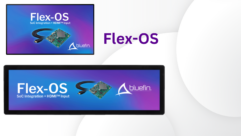
Enhancing Corporate Communications via Dynamic Digital Signage
Apr 29, 2010 5:21 PM,
By Maria Porco, X2O Media
Realtime messages to the right person at the right time in the right place.

X2O Media’s X2O enterprise communication platform enables companies to quickly and easily display content in the form of desktop TV channels, scrolling news feeds, or data-driven screen savers on employee desktops, mobile devices, digital signage displays, and interactive kiosks.
With corporate cutbacks and an economy trying to get back on its feet, corporations of all sizes are struggling to find cost-effective ways to communicate timely information to their busy employees. More than ever, employees need to be kept informed of company policies, the latest company news, and employee benefits, but few have the time to keep up with traditional message vehicles such as e-mails, the company intranet, static posters, or printed pamphlets.
Related Links

When Marshall McLuhan said, “The medium is the message,” it was 1964, and although he meant all media, he foresaw the profound impact of the newest medium: television…

With Xpresenter 3, X2O Media takes content creation to the next level, combining unprecedented ease of use with the broadcast-quality video graphics the company is known for…

The Case for Digital Signage Content: Viewer Experience Strategies
There are three basic types of digital out of home (DOOH) networks that determine both the placement and approach to creating messages….
The traditional solutions available to companies have several limitations. A static poster, for example, isn’t very captivating and the content is quickly out of date. Small changes to a sign’s information are likely to go unnoticed, not to mention the cost of printing paper signs. Internal e-mails often get lost in the shuffle as employees struggle to wade through their inboxes. An obvious problem with both of these approaches is that they’re dependent on employees having e-mail access or being at the physical location to look at signs. Most importantly, in this era of social media and instant messaging, information changes so quickly that by the time the employee gets to read it, it’s likely outdated. Add the fact that workforces are increasingly mobile, and one quickly sees that these traditional methods simply aren’t practical for real-time communication.
A dynamic and cost-effective way to enhance internal communications is through the use of digital signage. By utilizing digital signs that communicate relevant, timely information, companies can cut through the e-mail clutter, engage employees and maintain their interest, and even provide the opportunity for employee feedback. As digital signage becomes more and more prolific as a workplace tool, it is increasingly imperative for commercial integrators to have an understanding of its possibilities to best fulfill their clients’ needs.
With the right digital signage solution, information can be delivered not only to digital screens throughout a facility, but directly to employee computer screens in real time, with message pop ups right on their desktops. These pop ups can contain an entire message or a video, provide a link for more information, or give a brief summary of the announcement. Employees can quickly read the message and move on with their day. The message can also serve as an emergency alert, quickly notifying staff in the event of a fire or other urgent situation.
This same content can be sent to cell phones or other mobile devices, providing an effective tool for getting timely information to employees who are out of the office or away from their desks. Content can also be sent to interactive kiosks located throughout the building to engage employees, or it can go to digital signage displays, allowing companies to replace static signs, with more valuable instructional videos.
When evaluating digital signage platforms for internal communications purposes, there are some key features to consider. First, look for a platform that can go beyond just sending messages to digital screens, including employee computer desktops, mobile phones, and interactive kiosks. Second, the platform should integrate with other internal sources, such as scheduling software, making it simple to automatically update certain content throughout the network. Finally, it should offer the ability to target a specific department, a group of employees, or all employees and screens.
For example, since many corporations use the Microsoft SharePoint suite of server capabilities for enterprise-wide content management, the right digital signage solution should offer simple integration with these types of systems to streamline message creation and distribution. Whether with Microsoft SharePoint or other content sources, tight integration between systems enables users to communicate information already entered in one system to a subset or all employees in real time, without additional work. Content can be sent to any number of screens simultaneously, allowing targeting of messages to the right person, at the right time, in the right place. Information on upcoming events, company announcements, schedules, and business dashboard data is automatically formatted and displayed as high-end, broadcast-quality graphics on employee desktops and mobile devices.
Most of us are familiar with digital signage as content on a digital display. We see it all round us, finding it everywhere from retail outlets to churches. The intent of this signage runs from useful and informative, such as the arrival/departure boards in an airport, to revenue-generating advertising billboards. However, it is also perfectly suited to enhance internal communications, and is a powerful tool to help integrators meet their corporate clients’ needs.
Maria Porco is vice president of business development for X2O Media, a full-service provider of software, network management services, and content services for professional digital signage and corporate communication applications. She can be reached at [email protected].










